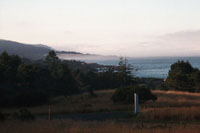


 |
 |
 |
It was morning and I had the time. What could I do? I pretty
much had to dive. But that's not so bad. I was back at Sea
Ranch on the north Sonoma Coast and the diving is
fantastic.
Debbie and I drove about a 1/2 mile from the house we rented,
down the nearest road that looked like it went to the water
and looked for a trail. I was suited up already and my other
gear was in my innertube backpack, so it is only a couple of
minutes from parking the car until I was at the bluffs
overlooking a beautiful calm rocky cove. I didn't forget to
pore warm water down my suit first though. Since there were
a couple of divers already out, that made the decision where
to go quite easy.
It's an easy hike down the rocks, pull my mask and fins out
of my backpack and then it's a dive float and game holder.
It also holds my booties. Luckily for me I don't get cold
feet, because I don't wear booties under my fins and the
water is a brisk 50 degrees.
As I headed into the water, one of the divers was coming in
through the rocks. He said his brother was staying out for
a while to do more 'shopping', but he already had his limit
of abalone. He said the vis was good and there were some
nice abs to be had.
I had never used one of these innertube backpacks before
and they are fantastic. I already liked how the straps
across the back, made it a convenient backpack for
carrying gear. Now I liked how it made it easy to glide
across the thick low tide kelp and shallow rocks. I
puttered out about 70 yards to where the second diver
was and made my greetings. He was having a good time
diving inside of a house sized reef that stuck just a
bit above the surface and made a nice calm spot. He had
his limit though and headed in.
I unzipped the float, got my ab iron and pulled out my
line that would snap onto kelp or just hang and tangle
to keep the float nearby. Now it was time to see if I
still had the touch... or maybe it's the breath.
I snapped a good surface dive with my feet high in the
air to push me down and went to the edge of some rocks.
There was a vivid magenta anemone and some small fish
to see, but no abalone. The dive was short, but I knew
it would take time for me to adjust.
It seemed that the terrain was mostly large rocks
sticking up vertically from sand channels at the bottom.
On the top of the rocks grew big bull kelp that came up to the surface.
I continued to dive but started heading straight down to
the bottom of the rock walls to about 25 feet. Soon, I
knew I still had the touch. I was hitting the bottom and
heading off through the sand channels looking for abalone
along the base of the rock walls. Unfortunately, the
sheer rock walls offered pretty much no cover for abalone,
though there were numerous large anemones in the small
cracks as well as lots of smaller fish. Vis was say 15,
maybe 20 feet, which is good for here and plenty for
diving. The thick kelp was what usually limited vis.
I was finding some boulders and cover, but still no abs
so I kept moving on. Then I found an opening about 4
feet deep, a few feet wide, that went into the rock for
a body length or so. It was perfect habitat for an
abalone to wait for kelp leaves to fall down into for
lunch and sure enough there was a nice keeper at the
back. That was in the bag.
Still, I thought that I should be seeing more abs so
I decided to try to get into the heavy kelp and see
if there were more cracks, boulders or other broken
terrain that would give cover for abs. The kelp was
very thick and tough on top of the rocks, but there
were cracks that I could get in under the kelp and
follow to the outside of the reefs. The abalone were
still spotty though and I wanted to find big ones to
fill my limit.
It was pretty diving with lots of crabs, colorful
anemones, pilaster stars, small fish and other
invertebrates, though notably very few large urchins.
I gave up diving into the thick kelp. It was a bit
thick by this time of the summer.
Well, I had seen many abs, only a few shorts, but only
a few nice keepers as well. There were occasional holes
with 6 or 8 nice ones together, but nothing huge. I had
one that I was disappointed in. It was plenty legal, but
I found it well hidden under a rock and had thought
'score, a hidden biggy'. I popped it off and was
disappointed because I could tell it was nothing special
sized.
My diving was good and I could still go down and
comfortably cruise. Due to my recent lack of exercise
and back problems, that had not been a given. I was
feeling great, but I didn't think it wise to push it.
It was time to find one more nice sizer and get
out.
Once again, the float was wonderful. I had my game in
it, to which I added my iron and weight belt. I climbed
on top and it still went through the water without
dragging.
The other divers had nicely taken their time to move out
in case I might need any assistance. Really, I guess few
people are used to soloing out here, though I have done
it enough to be comfortable. It is a strong custom up
here to look out for other divers. They helped me get my
gear up on higher rocks.
Ah.. Another fantastic north coast dive. There is nothing
I like better. Now it was time for the short trip back to
the hot tub.

Sea Ranch is one of the most beautiful places on the
California Coast and one of the most private. Many years
ago some partners bought the northern most 10 miles of
the Sonoma Coast, extending up to the Gualala River and
planned a development of summer homes that would fit into
coast with a light touch. Regulations said that all
houses had to have a natural wood exterior and many
houses were designed as architectural dreams. It is some
of the most easily accessed shoreline of the entire coast
with mostly low bluffs above the shore instead of the
towering cliffs that line much of the coast. They deeded
some miles of the shoreline to public access so as to
keep the state happy, but the central section was
strictly off limits and will quickly get a wheel boot for
anyone parked without a permit. Eventually, the Coastal
Commission forced them to make some other accesses, but
they are long walks. The houses are widely spaced, but
grouped together with a 1/4 mile or so between them.
The quiet, protected properties are filled with deer,
rabbits and many other animals that are too shy to be
often seen.
We rented a house that seemed to be Fen Shui approved
with a strong touch of Frank Lloyd Wright to the
design and decor. A peculiarity of the Sea Ranch is
that curtains and blinds are not allowed. The area is
so private that it is not an issue, but the house can
sure get sunny. When it gets cold, most heat comes
from the circular glassed fireplace in the living
room. The interior is all raw sanded redwood. There is
a beautiful shoreline view and binoculars out on the
coffee table for enjoying it.
It was a clear sunny afternoon when Curt called me
from the bluff top house that they had rented about
a mile away in another part of the Ranch. I quickly
got loaded up and drove there. The house was another
typically complicated design with a large comfortable
living room just made for relaxing while watching the
nearby shore. There was a nice patio as well, that
was shaped to be protected from the wind. Curt and Chris
were preparing their gear and Doris was coming on this
trip for support and camera management.
We all had our innertube packs on and headed the perhaps
150 feet along the trail across the meadow to the bluff
top. Then it was a short walk through small brush trails
to a path down the cliff. It is a short, but very careful
hike down the rocks to the water.
We headed out on our innertubes along the side of a rock
that stuck out into the cove perhaps 75 yards. Chris picked a
spot about halfway out while Curt and I headed out towards the
end. Vis was nice and got better as we went out.
A legal red abalone is 7 inches and all divers are required to
have a caliper measure with them. Curt had a 9 inch caliper
and wanted to find some biggies.
The diving was easy and no more than 25 feet to the bottom.
there were occasional nice sized abs, but not many monsters.
Lots of small jellyfish were in the surface waters near the
end of the rocks. There were also lots of multi-colored
anemones, small rock fish and large red urchins.
Curt came up at one point and had found a nice ab just
under 9 inches. That was a definite keeper. I had swam
through one crack where I had seen at least a dozen
abs that were bigger than 8 inches, but I too was
looking for big ones.
Chris was working the same spot further in along the
rock wall. I think he hunts abalone the way he hunts
lobsters. He had a light mounted on the side of his
mask and I expect that he was crawling in every hole
that he could find. I think he was using an iron to
get them off and not just his hands...
At the end of the rock was an area the size of a small
Jacuzzi that had constant waves washing into it. I
couldn't resist going into it even though it was just
a constant white out. When it calmed between waves I
could see that it was very shallow with thick seaweeds
and no cover. I finally found that one side had a body
wide crack about 8 feet deep heading out. It was well
worth following because it was filled with hand sized
anemones of every color.
I made a few more dives and then got to do one of my
favorite things when diving. The last rock out was the size
of a kitchen table and covered with sea palms. The waves
were going over it, but not badly, so I climbed out on
it to relax and enjoy the view. About 6 feet away, Curt
was diving in 25 feet of water. That pool I had been in was
behind me and the larger waves that were coming in just now
made me really glad that I had left it. After a while it
was time to go in and do a few dives before leaving. I didn't
feel that I could push it. One good mistake with my back and
I wouldn't be walking. I had my limit of some nice large
fattys, but nothing was 9 inches.
 |
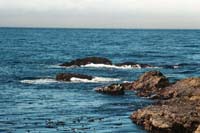 |
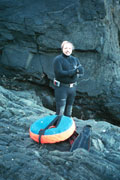 |
About this time Chris showed up. He had done really well with finding some large abs, though nothing that was 9 inches. He and Curt decided to swim another 75 yards out to an isolated rock that was sticking up. Regretfully, I headed for shore as they headed out. Again, the float was great for holding my iron, weightbelt, game and me on top.
 |
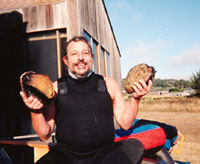 |
 |
The story was that when Curt and Chris got to the rock
they dropped down along a rock wall and saw a number of
huge abs, some of which were easily 9 inches. Curt took
one and Chris got another large fatty, but that was limits
for them, so it was time to swim back. We got our gear off
and started cleaning some abs for dinner. It's nice when
there are others helping. Usually, that is my job alone. I
went back and got Debbie for dinner. Abalone were cooked
breaded and in cooked almond chips. Doris and Curt make a
good cooking team. It was some truly tender abalone. Not
only did Doris provide a delicious spinach dish with dinner,
it turned out that she has a great taste in red wines. I
was definately prepared for a beautiful north coast sunset
to end the day.

I've already described what a beautiful drive it is along the coast
from Sea Ranch to Albion in
Dive Crazy Diving.
This trip was beautiful again, but
considerably more foggy than the last time and just as rushed.
We got to the dock in the forested river valley of the Albion River
and everyone was soon ready to go. It was
also more foggy on the water than the last time. As we left
the harbor, Captain Matt said that radar showed that we were
surrounded by boats. They were completely invisible in the fog.
Since the trip had been planned for abalone diving instead of
scuba, his objective was to get far enough south that we would
be beyond where many boats were able comfortably go. In this
fast boat, that meant about 45 minutes. It is a strange trip
through the fog. Sometimes you could see a few hundred yards,
but most times it was far less than that.
Here I must put in a disclaimer. I brought along my wife for
sight seeing. That was a mistake. It was not sunny like last
time. It was cold and foggy. There is really no cover on this
boat. It is fine if you are in a wetsuit. Better if you are in
a warm wind jacket over your wetsuit. If you are not set up
very cold and water resistant, it can be miserable. She
was.
Anyway, we went a long way through the fog, down the coast and
then we could see our destination. About 150 yards in, above
the shore, was a middling cliff down
to the water and some offshore rocks. In from the boat, there
were numerous rocks together forming a bit of a reef about 75
yards from shore. There were 2 car sized wash rocks sticking up
about 75 yards out from the boat as well. Most of the divers went
to the inner rocks. Curt and I decided to go out to the wash
rocks.

Vis was fairly poor. It was lucky if it was 10 feet. Luckily,
for this kind of diving, vis is fairly irrelevant. The abalone are
camouflaged in the weeds and cracks such that you are not likely to
see them from much more than 6 feet anyway. They are instinctively
hiding from the otters that are no longer there... just now. The
objective is just to get to somewhere that few people have ever
visited and see if there is some huge abalone stashed somewhere
that either no one noticed or else they weren't able to get out.
Abalone may be in holes that they fit in, but nothing else is going
to. Curt had along his 9 inch measure. He was looking for fairly
serious biggies.
The bottom was large rocks in about 25 feet of water with rock
or narrow sand channels between them. The rocks flattened out in
about 12 feet of water and they were covered with thick red algaes
that stick up less than a foot. Among these short thick leafy
algaes, are the small holdfasts of bull kelps that come up to or
near the surface.
You have a choice here. You can dive to the bottom of the
rocks at about 25 feet and look along the rock sides or you can
try to look through the thick algaes on the tops of the rocks.
In both cases you are looking for holes and cracks that are good
habitat for the abalone. Either way, these are basically huge
flattened snails and aren't always so bright. You may just find
a big one out in the open on top of a rock. What you really want
to look for though, especially in areas that have some diving
pressure, is a small hidey hole under a rock or some other hole
that you figure is well enough hidden that other divers probably
didn't look there. That is where you may find a really big one.
Or it may be just completely out in the open... You just have
to look.
Another thing to look for are cracks that are wide enough to
swim through and up to 6 feet deep. There are a couple of reasons
to look for these. The first is that they catch kelp leaves and
so there is food for abalone. There may be a lot of abalone and
you can look for a big one. Also, if the water is rough, these
cracks can provide a very comfortable calm spot to swim in.
Sometimes they may be a calm spot just under the surface of big
waves. The other reason to swim in them is that they provide
protection to fish, crabs, urchins, anemones and many other
species besides abalone. They are extremely beautiful, protected
areas.
I searched the different parts of the reef as did Curt. He did
find one nice one in the 9 inch range. I decided to climb out
on a rock and relax. I was out for just a couple of minutes when
a bigger wave came by. It didn't knock me off, but it made it
about a 4 foot fall off the back of the rock and I decided to
go while the going wasn't painful.
It just wasn't anything special out there, so when Curt suggested
trying in where the others were, I readily agreed.
The rest of the divers were strung out along a series
of wash rocks about 75 yards from shore that marked a
very large shallow reef area. Chris seemed to have staked
out an area just next to a truck sized rock and was
working the rough area next to it where there was some
wave action.
I found a likely looking spot (there is a lot of those
in the untracked ocean) and started diving. It was nice
that there was so little current that I didn't try to
anchor my inner tube any. It never really went
anywhere.
There was better terrain here. There were lots of the
cracks that went down 3 or 4 feet and were wide enough
to dive in. At first I didn't see many abalone, but
then I started getting into cracks that might have a
dozen in them. The lower you get in the crack, the
better you can see and the better control of your
movements you have. I just kept looking for hidey
holes or in the groups to try to find some big
ones. There were numerous of the bright magenta
anemones and some crabs in the cracks as
well.
 |
 |
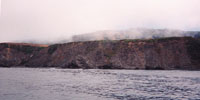 |
Conditions like these are what I have said make some of the best divers in the world. The vis was crummy, maybe 8 feet, at times it gets much worse. Though this was a very calm day, for up there, it still was ocean waves coming from Japan and Alaska. North Coast divers continue to dive on even moderate days and that can be a very rough day indeed. The experienced hunters are able to dive effectively among wash rocks where there may be white outs and surges from waves can suddenly grab you and whip you into a rock at high speed. But these divers know how to read the terrain so that they can move and hold their bodies such that are able to hide from the currents or ride them without harm. Free diving in waves and kelp forces them to have their gear configured to slide through the water without ever dragging, snagging or coming loose in a wave. The heavy wetsuit they need does not stop them from swimming relaxed and efficient with a graceful speed. The senses of the hunter are hightened by natural instincts to understand everything they see in a glance and to react instantly to anything they do see. Since they are filling the nitch of the sea otter, they must move with a similar style, quickly moving around and under rocks, positioning to look in holes and dodging things that suddenly appear out of the gloom. The north coast divers of California are comfortable in conditions that are more challenging and hostile than most divers from elsewhere, ever see.
Eventually, I figured it was time to finish up and get
back to the boat. I looked for some fattys to finish my
limit. Really, a deep 8 1/2 incher is going to have as
much meat as a flatter 9 inch abalone. With my limit
done, I climbed on my float and headed back to the boat.
Before long, the other divers were returning as well.
Pretty much everyone had gotten their limits. Curt had
gotten a couple that were 9 inch, but the biggest one
had been found by Chris. He had found a monster that
was over 9 1/2 inches and was incredibly deep. A wild
guess is that it had 5 pounds of meat in it.
The return trip was another journey in the fog. It was
just big enough for the swell to pound the boat a bit,
but not big enough to make the waves have a long
period. I was glad when we got to the cove at the river
mouth. The fog was thinning a bit there and the entrance
to the cove, under the old Albion Bridge, is
beautiful.
The innertube floats are wonderfully convenient. The only
drawback to them that I can see is that you do have to
keep track of them some or tie them off. Normally that is
not a problem and this trip it wasn't, but in the past, I
have tried to avoid having a float because I am more likely
to go exploring a distance. A single freedive may move me
75 feet down the coast. It's not like that's needed, but
when I can explore, it is fun. the other drawback, that
wasn't a problem this time, is that I often like to go
into very rough water where a float would get pushed
away or ever perhaps brought to shore. This time, I it
was pretty much calm and I wouldn't have felt comfortable
diving into the surf anyway.
Chris was using a piece of gear that I have seen but never
used. It is a ~30 foot piece of plastic tubeing that has had
flourescent paint poored through it. You tie one end to your
float and the other end to your ab iron. If you see something
big but you can't get it on one breath, you drop your ab iron
and surface. Then you can dive again and follow the line to
where you were before. Apparently, he and Curt, using it
together, were able to get two 9 inch plus abalone on their
last dive at Sea Ranch.
The drive back was a bit less foggy. We stopped at the Point Arena Seafood Festival and Abalone Competition at the pier in Point Arenan. It was an interesting stop with a band, fish kabobs, fish tacos, pies, cookies and lots of other consumables. If you want to compete in the abalone competition, you have to register at by 10 am. Expect a 10 inch plus abalone to take the competition.
The next morning showed another incredibly beautiful day. Unfortunately,
we had to get packed and head back home. I wanted to get some last
photos so I went back to where Curt and Chris were staying. They
were leaving later and so had planned on a last dive that morning.
I would have loved to make another dive, but I didn't think I had
time to join them.
It was another morning with excellent conditions. They were planning
on going straight to the outer rock where they had seen big abs
before. They would fill their limits with 2 abs, so the
plan was to take nothing under 9 inches.

This is what Curt told me about the dive. I wish I had been there.
Chris and I made our last dive out to the rock for about an hour. The vis was magical. I could clearly see my 4" square weight lying in the troughs of white sand holding my dive float in place. The sun was beaming thru the ripples of what should be waves just like the rays of light piercing thru a cloudburst. I saw a VW size boulder off by itself and thought that might hold some trophies. I figured how would anybody even know it was there in a normal 10' of vis. I dove down and surveyed the rock and did not find a single ab. Discouraged I swam over to the outer rock, the same location where I had been to on Friday when I got a 9.5" However, I could not locate the same spot underwater and was having a hard time finding good abs. The diving was beautiful and despite the abs I was having the best of times enjoying the sights. I poked around here and there in different kelp clusters until Chris found a spot he said had some big abs. I moved the float in and set the anchor in the vicinity. Made a couple of dives and a spotted a couple of keepers. We needed two to limit out. I discussed the spot with Chris and it was apparent it was the spot he found. I made a dive gauged two, then another I found was over 9 inch so I popped it, gauged another - over 9 inch and popped it too. As I headed to the surface I dropped my 9 inch gauge. At the float I told Chris I got two 9'ers and he replied 'let's go'. 'Oh no' I said 'I have to get my gauge'. I dove back and in the clear water, by north coast standards, and found the gauge lying next to another large 9'er. It will wait for the next trip. There is always a reason to go back.
 |
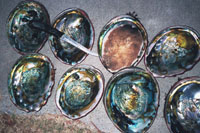 |
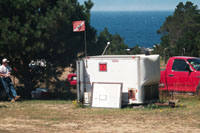 |
Big ab of the trip goes to Chris. He got two in the 9 1/2 inch range that were both incredibly deep. They must have had about 5 pounds of meat each.
Sometimes, I try to fix in my mind a picture of the beauty I see when I dive. It is so fleeting and the image fades like a sunset. I guess that is all right, because then I must go back and do it again.
More About The North Coast with Links and Phone Numbers